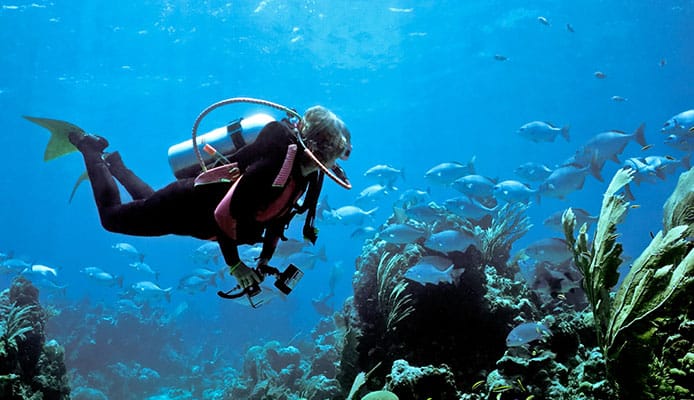
Exploring the underwater world poses many dangers, including the crushing water pressure that increases rapidly with depth. Despite this, scuba divers have pushed on, trying to set a new record by diving longer and deeper every year.
Current dive records are awe arousing, with Ahmed Gabr’s being the greatest at 332 meters (1082 feet). This technically means that the guy was experiencing water pressure of about 485 pounds per sq. Inch. Trust us, most diver’s lungs would have squashed at that depth. And this brings us to our topic ‘exactly how deep can you scuba dive?’
The right depth for scuba diving is 130 feet. However, this is determined by various factors including the level of experience, buoyancy control, personal tolerance for high pressure, and the ability to save air when diving.
Understanding Deep Sea Diving
The maximum depth for certified, skilled recreational divers inhaling the right amount of air is 130 feet. This is the depth set by most scuba diving agencies and every underwater enthusiast should obey this rule, as it’s one of the most important scuba diving safety precautions.
Of course, technical divers have descended past 1000 feet on really risky missions but a recreational diver has no business breaking the recommended depth limits. Divers have lost their lives trying to set a new depth record. They know deep-sea diving is a risky endeavor but they still want to push their limits and make discoveries.
So, if 130 feet is the recommended depth, how did guys like Gabr manage to get past this, you may ask? It’s simple, proper dive training. People go beyond the suggested depth all the time. However, pushing your body to such limits requires plenty of experience.
You have to spend a lot of time perfecting your scuba diving breathing techniques, learning how to prevent or deal with common dive injuries like ear barotrauma, and familiarizing yourself with decompression procedures. You may also need to take trimix courses just to get acquainted with trimix diving. In other words, such an undertaking will require you to take as much training as possible to avoid deep-sea scuba diving dangers and risks.
Risks Associated With Deep Sea Diving
Deep-sea diving is fairly safe as long as you heed all the guidelines and rules. However, every diver needs to know the risks of descending beyond the recommended depths.
1. Decompression Sickness
When you start descending, your body takes in air, which is usually composed of nitrogen, oxygen, and other gases. Oxygen is used by your body but nitrogen is eventually expelled over time since it is not required by the body.
Now, when you make a quick ascent, the pressure exerted on your body drops suddenly causing the nitrogen inside your body to expand and create bubbles. These bubbles get trapped in your joints causing you awful pain. That’s why it is recommended that divers ascend slowly and not exceed the maximum ascent rate for scuba diving.
2. Rapid Air Consumption
When you dive, you breathe in air at the water pressure around you. The deeper you go, the more the air you breathe gets compressed. At 130 feet, you will be depleting your scuba tank five times faster than when you are at a depth of 10 feet.
If you plan to dive to this depth, you will realize that you will spend less time underwater than when diving at 40 or 50 feet. Not only that. You will require a bigger tank to support the long ascent from the deep dive.
3. Nitrogen Narcosis
Nitrogen narcosis is real and every diver will experience it at some point in his underwater adventures. You will experience a drunken feeling when your body takes in too much oxygen. This is especially true if you are spending too much time underwater or taking shorter surface intervals than required between dives.
The first symptoms will be tingling fingers, disorientation, and dizziness. You may also experience blurred vision, making reading your dive computer, scuba gauge, and other instruments difficult. The deeper you go, the more nitrogen your body consumes, and the more affected you will be by nitrogen narcosis.
4. Oxygen Toxicity
Did you know that sometimes too much oxygen is not good for divers? Yup! At a very high concentration, oxygen can become poisonous causing unconsciousness and even worse, death.
At a depth of about 220 feet, the oxygen in your air reserve may become toxic. This condition occurs when the concentration of oxygen is too high for your specific dive depth. Symptoms can be nausea vomiting, dizziness, and having trouble breathing. But oxygen toxicity should not be a concern if you train adequately and follow the right recreational depth procedures.
You might also like: Nitrogen Narcosis: The Martini Effect In Scuba Diving
How To Do Your First Deep Sea Dive Safely
“How deep can you scuba dive safely?” is a common question among first-time deep-sea divers. Well, if you are taking your first deep dive, you should have it supervised by a certified instructor.
During your open water diving certification course, you will be trained at a depth of 30 meters. Depending on where you are taking your course, you may have an option to enroll in deep diving courses where you will train to dive at 40 meters.
Once you are certified, continue practicing and every time, take an experienced dive buddy with you until you are confident to dive on your own. During your first day, avoid diving beyond your planned depth or taking more time underwater than predicted. Keep monitoring your pressure gauge and depth and most importantly ensure that your tank has enough air for the ascent.
Globo Surf Overview
While deeper dives get you enjoying pristine reefs and bountiful species of marine animals than shallow dives, at times, they can be quite dangerous. Divers are, therefore, advised to approach them with caution to stay safe underwater. Take as much training as you possibly can and if possible, have a dive instructor or qualified guide with you when taking your first deep dive.
More Scuba Reviews:
- Dive Camera
- Dive Light
- Full Face Scuba Mask
- Dive Watches Under 200
- Dive Watch Under 1000
- Moray Eel
- Suunto Zoop Novo


